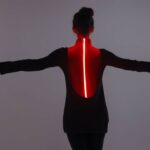Last Updated on 5 months by Francis
In recent years, far infrared technology has gained popularity for its potential therapeutic benefits. But one question has remained at the forefront of discussion – can far infrared penetrate clothing?
Understanding the interactions between far infrared and different materials is key to unlocking the potential benefits of this technology in clothing. In this article, we’ll explore the science behind infrared technology, the properties of far infrared, and the factors that affect its penetration through clothing.
Contents
Key Takeaways:
- Far infrared technology has potential therapeutic benefits when incorporated into clothing.
- The ability of far infrared to penetrate clothing depends on various factors.
- Different clothing materials have varying abilities to allow far infrared waves to pass through.
- Far infrared clothing may hold promise for improved physical performance and pain relief.
- Practical considerations, such as comfort and durability, need to be taken into account when incorporating far infrared technology into everyday garments.
The Science Behind Infrared Technology
To understand how far infrared can potentially penetrate clothing, it’s important to first explore the science behind infrared technology. Infrared radiation is a type of electromagnetic radiation, which encompasses a broad spectrum of wavelengths, including visible light, radio waves, and X-rays. Infrared radiation falls in the range between visible light and radio waves, with longer wavelengths and lower frequencies than visible light.
Infrared radiation is emitted by all objects that have a temperature above absolute zero. The amount of infrared radiation emitted varies based on the temperature of the object; hotter objects emit more infrared radiation than cooler ones. This is why we can feel the warmth of the sun or a fire, as these objects are emitting infrared radiation that our bodies can detect.
Infrared technology has various applications in different industries, and it’s been used for decades in the healthcare sector for remote temperature measurement and therapy. Recently, there’s been a growing interest in incorporating infrared technology into clothing, with the potential benefits ranging from improved athletic performance to therapeutic effects.
Clothing that incorporates infrared technology works by using special fibers or materials that are able to absorb and emit infrared radiation. The clothing then reflects the emitted infrared radiation back onto the wearer’s skin, providing a warming sensation and potentially offering therapeutic benefits, such as improved circulation and pain relief.
While the idea of infrared technology in clothing is relatively new, research into its potential benefits continues to grow. By understanding the science behind infrared radiation and how it interacts with different materials, we can better explore the potential applications of this technology in clothing.
The Properties of Far Infrared

Far infrared is a type of infrared radiation that has unique properties. When it comes to clothing, far infrared technology is often used for its potential therapeutic benefits. The key to understanding these benefits lies in how far infrared interacts with the human body.
Unlike other types of radiation, far infrared waves are longer and can penetrate deeper into the body. This penetration can have a soothing effect on the muscles and joints, making far infrared therapy clothing a popular choice for athletes, individuals with chronic pain, and those seeking relaxation and stress relief.
Far infrared technology is often harnessed through the use of specialized fabrics and materials. These fabrics contain ceramic particles that emit far infrared waves when exposed to body heat. The use of such far infrared fabric in clothing allows for the therapeutic benefits of far infrared to be delivered directly to the body.
One of the key advantages of using far infrared therapy clothing is that it can provide targeted relief to specific areas of the body. For example, a knee brace infused with far infrared technology can help alleviate pain and stiffness in the knee joint.
Overall, the properties of far infrared make it a valuable tool in the development of therapeutic clothing. By utilizing the unique properties of this type of radiation, clothing can be designed to provide targeted relief and enhance physical performance.
Understanding Clothing Materials

When it comes to far infrared penetration, not all clothing materials are created equal. Some fabrics may inhibit the transmission of infrared waves, while others may allow for greater penetration. Understanding the properties of different materials is crucial to determining whether far infrared can indeed penetrate clothing.
One of the factors that influence infrared penetration is the thickness of the fabric. Thicker materials, such as denim and wool, may act as a barrier to infrared waves and prevent them from passing through. Lighter fabrics, such as cotton and silk, may allow for greater penetration.
Another factor to consider is the density of the fabric. Dense materials, such as synthetic blends, may absorb infrared waves and prevent them from penetrating through to the skin. Looser weaves, such as those found in some natural fabrics, may allow for greater infrared transmission.
It’s important to note that simply wearing clothing made from a specific material does not guarantee far infrared penetration. The weave, thickness, and overall design of the garment can all impact infrared transmission.
So, what types of clothing materials are more likely to allow for far infrared transmission? Some fabrics that are commonly used in far infrared clothing include:
| Material | Properties |
|---|---|
| Bamboo | Naturally breathable, moisture-wicking, and antimicrobial. May allow for good infrared transmission due to its loose weave. |
| Carbon-infused fabrics | Designed specifically to enhance infrared transmission. May be more effective than natural fabrics for far infrared technology. |
| Merino wool | A natural fiber that is soft, breathable, and moisture-wicking. May allow for infrared transmission due to its lighter weight and looser weave. |
| Nylon/spandex blends | A synthetic blend that can be designed to have a lightweight, breathable feel. May allow for infrared transmission depending on its density and weave. |
| Polyester blends | A synthetic blend that can be designed to have moisture-wicking properties. May allow for infrared transmission depending on its density and weave. |
While these fabrics may be more conducive to far infrared transmission, it’s important to note that individual garments may still vary depending on their design and construction.
The Factors Affecting Infrared Penetration

When it comes to understanding the benefits of far infrared through clothing, it’s important to consider the factors that affect infrared penetration. While certain fabrics may allow for infrared waves to pass through, there are other elements that can impact their ability to penetrate clothing. Here are a few key factors to consider:
- The thickness and density of the fabric: Thicker, more densely woven fabrics can be more effective at blocking infrared waves. In contrast, thinner, more breathable fabrics may allow for greater infrared penetration.
- The type of fabric: Certain materials, such as cotton and silk, are more transparent to infrared radiation than others, like wool and synthetic fibers.
- The distance between the fabric and the skin: The closer the fabric is to the skin, the greater the potential for infrared penetration. Loose-fitting clothing may allow for more air circulation and limit the amount of infrared that reaches the skin.
While these factors can influence the ability of infrared waves to penetrate clothing, studies have shown that certain fabrics can indeed allow for far infrared penetration, which can offer potential benefits to wearers.
Experimental Studies on Infrared Penetration

To determine the extent of infrared penetration through clothing, several experimental studies have been conducted. These studies have utilized different testing methods and materials to provide insight into the capabilities of far infrared and its interaction with fabrics.
One study analyzed the penetration of far infrared through various fabrics, including cotton, nylon, and polyester. The results showed that cotton and nylon allowed for greater infrared penetration compared to polyester, which acted as a barrier to far infrared.
Another study focused on the effects of wearing far infrared garments on muscle activity and blood flow. The results showed a significant increase in muscle activity and blood flow, indicating potential benefits for athletes and individuals with circulation issues.
“The results showed that cotton and nylon allowed for greater infrared penetration compared to polyester, which acted as a barrier to far infrared.”
A third study examined the effects of far infrared on chronic lower back pain. Participants were instructed to wear far infrared therapy clothing for eight weeks, and the results showed a significant reduction in pain levels.
Overall, these experimental studies demonstrate the potential of far infrared technology in clothing and its ability to penetrate certain fabrics. As research continues, it’s likely that we will gain a better understanding of the capabilities and limitations of this technology in the context of clothing.
The Debate: Does Clothing Act as a Barrier to Far Infrared?

One of the central questions surrounding the use of far infrared in clothing is whether or not clothing acts as a barrier to this type of infrared radiation. Some claim that far infrared cannot penetrate clothing, while others argue that it can.
Those who believe that clothing inhibits far infrared penetration point to the fact that infrared heat is often used to keep individuals warm in colder temperatures. If far infrared were able to pass through clothing, it would not be as effective in keeping the body warm. Additionally, some fabrics, such as cotton and polyester, are known to be poor conductors of heat, further supporting the argument that far infrared cannot penetrate clothing made from these materials.
On the other hand, proponents of far infrared technology in clothing argue that certain fabrics, such as bamboo and nylon, are more conducive to infrared penetration. They also point to studies that have shown that far infrared can penetrate several layers of clothing and still have an effect on the body.
While the debate continues, it is important to consider the potential limitations of incorporating far infrared technology into clothing. If far infrared cannot penetrate clothing effectively, it may not have the desired therapeutic or performance-enhancing effects. However, with the right fabrics and materials, far infrared clothing could offer a wide range of benefits.
The Future of Far Infrared Clothing

As far infrared technology continues to advance, the future possibilities of integrating this technology into clothing are endless. From sports apparel to everyday wear, far infrared clothing holds the promise of various benefits.
One area where far infrared clothing may have significant potential is in the field of athletic performance. Studies have shown that far infrared can enhance blood circulation, reduce muscle fatigue, and even improve flexibility and range of motion. By incorporating this technology into sportswear, athletes may be able to push their limits further and recover more quickly from strenuous workouts.
Another area where far infrared clothing may be beneficial is in the realm of therapeutic wear. Far infrared therapy clothing is already being used to treat a variety of conditions, including arthritis, chronic pain, and poor circulation. By utilizing far infrared technology in everyday garments, individuals may be able to experience the benefits of this therapy more conveniently and comfortably.
However, as with any new technology, there are practical considerations to be addressed when it comes to implementing far infrared into clothing. One potential issue is the durability and care requirements of far infrared fabrics. It’s essential to ensure that the clothing remains effective after multiple washes and wears.
Another consideration is the comfort of the clothing. While far infrared technology may offer potential benefits, clothing that incorporates it must still be comfortable and easy to wear. The materials used must be breathable and non-irritating to the skin.
Overall, the future of far infrared clothing is exciting. As the technology continues to evolve, we may see even more applications of this powerful therapy in various industries.
Practical Considerations for Far Infrared Clothing

While the potential benefits of far infrared clothing are exciting, it’s important to consider the practical aspects of incorporating this technology into everyday garments.
Comfort is a key consideration. Clothing that utilizes far infrared technology often contains ceramic particles that can feel rough or abrasive against the skin. It’s important to choose clothing that balances the therapeutic benefits of the far infrared technology with comfort and wearability.
Durability is another factor to consider. Far infrared clothing may require special care, such as hand washing or avoiding high heat in the dryer, to prevent damage to the technology. It’s important to read and follow the care instructions for each garment carefully.
When it comes to infrared therapy clothing, it’s crucial to consult with a healthcare professional to ensure that it’s safe and appropriate for individual needs. It’s also important to note that far infrared clothing should not be used as a replacement for medical treatment or advice.
Ultimately, whether far infrared clothing is suitable for an individual will depend on their personal preferences and needs. While the potential benefits are promising, practical considerations must also be taken into account when deciding whether to incorporate far infrared technology into one’s wardrobe.
Infrared therapy clothing may provide various benefits, but comfort and durability are important considerations.
The Benefits of Far Infrared Clothing
Far infrared clothing has gained popularity in recent years, promising a range of potential benefits for wearers. Let’s take a closer look at some of the reported advantages:
Improved circulation
Far infrared technology can help stimulate blood flow and improve circulation. This can lead to a range of benefits, including reduced muscle pain and stiffness, improved recovery times after exercise, and a feeling of increased energy levels.
Pain relief
Wearing far infrared clothing has been shown to help alleviate pain and discomfort in a range of different conditions, including arthritis, fibromyalgia, and chronic fatigue syndrome. This is thought to be due to the ability of far infrared waves to penetrate deep into the body and promote healing.
| Condition | Reported benefits of far infrared clothing |
|---|---|
| Arthritis | Reduced pain and stiffness |
| Fibromyalgia | Improved sleep quality |
| Chronic fatigue syndrome | Reduced fatigue and improved energy levels |
Enhanced physical performance
Athletes and fitness enthusiasts have reported benefits from wearing far infrared clothing during exercise. The technology helps to warm up muscles and improve circulation, leading to improved performance and faster recovery times.
Other reported benefits
While further research is needed to confirm these benefits, some individuals have reported additional advantages from wearing far infrared clothing, including improved skin health and reduced stress levels.
Overall, the potential benefits of far infrared clothing are compelling. From therapeutic applications to performance-enhancing sportswear, the technology offers a range of possibilities for the future of clothing.
Conclusion
After exploring the intricate world of far infrared and clothing, we can conclude that the question of whether far infrared can penetrate clothing is complex. However, based on our research, it appears that certain fabrics and materials can allow for infrared penetration.
Understanding the science behind infrared technology and the properties of far infrared are crucial to unlocking its potential benefits in clothing. By examining the factors that affect infrared penetration and reviewing experimental studies, we can gain a better understanding of the capabilities of far infrared and its interaction with different fabrics.
While incorporating far infrared technology into clothing is promising, practical considerations should also be examined. Comfort, durability, and care requirements are essential elements to consider when designing clothing that utilizes far infrared technology.
Despite the challenges, the potential benefits of far infrared clothing are vast. Enhanced physical performance, pain relief, and improved circulation are just a few of the reported advantages of wearing garments infused with far infrared technology.
As this technology continues to develop, the future possibilities of integrating it into clothing are exciting. From performance-enhancing sportswear to therapeutic garments, the potential applications are endless.
As we conclude our examination of far infrared and clothing, it is clear that this technology holds immense potential for various industries. By continuing to explore its capabilities and limitations, we can unlock even more benefits and applications.
FAQ
Does far infrared penetrate clothing?
Yes, certain fabrics and materials can allow far infrared waves to penetrate clothing.
What is the science behind infrared technology?
Infrared technology utilizes infrared heat, which has various applications, including clothing.
What are the properties of far infrared?
Far infrared has unique properties and can interact with the human body, potentially offering therapeutic benefits.
Do all clothing materials allow for infrared penetration?
Not all clothing materials are created equal in terms of far infrared penetration. Some fabrics are better at allowing infrared waves to pass through.
What factors affect infrared penetration through clothing?
Factors such as fabric thickness and density can influence the extent of infrared penetration.
Are there experimental studies on infrared penetration?
Yes, several studies have been conducted to determine the extent of infrared penetration through clothing.
Does clothing act as a barrier to far infrared?
There are arguments both for and against clothing acting as a barrier to far infrared. The limitations of incorporating far infrared technology into clothing are also considered.
What is the future of far infrared clothing?
The future possibilities of integrating far infrared technology into clothing are vast, with potential applications in sportswear and therapeutic garments.
What are the practical considerations for far infrared clothing?
When incorporating far infrared technology into everyday garments, factors such as comfort, durability, and care requirements need to be considered.
What are the benefits of far infrared clothing?
Far infrared clothing has been reported to offer advantages such as improved circulation, pain relief, and enhanced physical performance.








